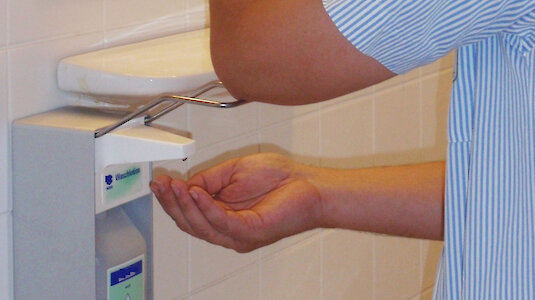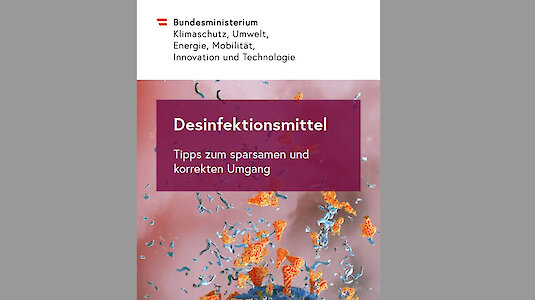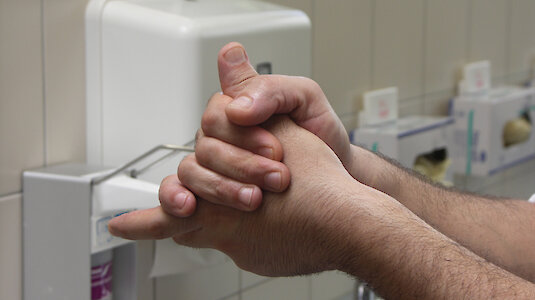Disinfection - when and where is it useful?
Read in the interview with biotechnologist Marion Jaros from the Vienna Environmental Ombudsman's Office what is important for the safe and economical use of disinfectants.
Ms Jaros, to what extent has the "disinfection behaviour" of Austrians changed or "increased" as a result of the pandemic?
Disinfectant manufacturers have reported that demand - especially for hand disinfectants - increased fivefold in some cases at the beginning of the pandemic. This is a clear sign that these products have increased in use amid concerns about covid19 infection. At the beginning of the pandemic, there were veritable hoarding purchases of disinfectants among the population. Since little was known about the virus at the beginning, this reaction was not entirely incomprehensible. However, in hospitals, where the use of disinfectants is essential, these products became scarce. Emergency approvals from the Ministry of Climate Change finally ensured that pharmacies and also distilleries for alcoholic beverages were allowed to produce disinfectants to make up the shortage more quickly.
One could also observe the increased use of disinfectants in everyday life. In restaurants, for example, tables were disinfected before each new guest and dispensers for hand disinfectants were everywhere in shops. However, investigations soon showed that although parts of the virus can still be detected on surfaces after several days, the infectivity decreases significantly after only a few minutes. Univ.Prof.in Miranda Suchomel from the Institute of Hygiene and Applied Immunology at MedUni Vienna pointed out in her publications that "infectious SARS-CoV-2 could practically never be detected on inanimate surfaces in the vicinity of COVID-19 patients, only the viral RNA."[1] She concluded from this, among other things, that public surfaces only need to be cleaned and not disinfected. Soap can also rapidly destroy the protein coat of coronaviruses, so hand disinfection is only useful in situations where hand washing is not possible.
Overall, therefore, far more disinfection was used during the pandemic than was actually indicated. Particularly problematic was the advertising of devices for permanent air disinfection when people are in the room at the same time. Relevant hygiene experts generally advise against this. Lung damage could be the result.
Will this increase the "careless" use of (unnecessary) disinfectants in 2023?
I do not have concrete sales figures that show whether disinfectant sales are still higher today than before the pandemic. However, it is not uncommon for disinfectant dispensers to remain in shops or restaurants and it can probably be assumed that disinfection measures common during the pandemic will continue to be practised by part of the population in a somewhat weakened form.
Where should disinfection be carried out in 2023 and with which chemical agents? Are there any official guidelines on this in Austria? Your recommendations?
There are many hygienic risk areas where disinfection measures make sense and are also legally required. In the area of food production and preparation, the HACCP guideline makes concrete specifications on disinfection measures, which of course have to be complied with. In the health and care sector, hygiene experts develop hygiene guidelines within the framework of working groups, which provide orientation. Wherever the use of disinfectants is essential, care should be taken to ensure that suitable and sufficiently effective products are used. In the professional sector, products should be selected whose effectiveness has been tested and certified by independent hygiene societies. In Austria, the Austrian Society for Hygiene, Microbiology and Preventive Medicine (ÖGHMP) has published a corresponding expert list. In Germany, the Association for Applied Hygiene (VAH) has published a similar list of disinfectants. But of course, not only efficacy or material compatibility is relevant. Since disinfectants have different, hazardous properties for the environment and/or health, one should also consider these two aspects.

Hand desinfection. Copyright by Marion Jaros.
What problems can arise from excessive use of disinfectants in terms of resistance, skin damage and environmental impact?
The biocidal agents contained in disinfectants are intended to kill microorganisms rapidly. Without appropriate protective measures, such substances can sometimes also damage the skin, eyes, lungs or other organs. When using surface disinfectants, skin and eyes must usually be protected from highly corrosive substances by gloves and protective goggles; some ingredients can also trigger allergies. In rare cases, risks to pregnant women and the child-to-be cannot be ruled out.
If disinfectant residues get into wastewater, they can also affect surface waters, especially if they are poorly degradable. For sensitive aquatic organisms such as daphnia or fish eggs, even the lowest concentrations can be fatal. The biological stage of sewage treatment plants also does not tolerate high concentrations of biocides in wastewater.
And a third effect must be taken into account. If the same active substances are used in low concentrations over a long period of time, there is a risk of pathogenic germs developing resistance, at least in the case of some active substances, such as the environmentally toxic quaternary ammonium compounds. They then become increasingly difficult to reduce with disinfection and are sometimes already antibiotic-resistant.
For all these reasons, disinfectants should not be used preventively in the household, i.e. without a specific indication such as a very contagious infection. Otherwise we blunt a weapon that we urgently need in hospitals and other areas.

Free download of the folder "Desinfectants - tips for avoidance and safe use" Cover: stock.adobe.com - dottedyeti.
On behalf of the Federal Ministry for Climate Protection, Environment, Energy, Mobility, Innovation and Technology (BMK), DIE UMWELTBERATUNG and the Federal Environment Agency (Umweltbundesamt) have jointly published a new folder in 2023, which explains in an easy-to-understand way when and how to use disinfectants correctly in everyday life and, above all, when not to. Free download of the folder "Disinfectants - tips for avoidance and safe use" here.
Are there disinfectants that have been certified with the Austrian Ecolabel? Other recommendable disinfectants?
There are currently no disinfectants with an Ecolabel. Since these products are never harmless due to their germicidal properties, any Ecolabel here is not intended to suggest harmlessness. However, in the criteria for the Ecolabel for schools, for example, there are specifications for the careful use of disinfection measures. We have successfully introduced the following proposals for the Ecolabel for schools as mandatory criteria:
- Do not use standard products with disinfectant additives ("antibacterial" etc.).
- If surface disinfection is necessary according to the hygiene regulations (HACCP), preferably use products based on oxygen scavengers, alcohol or organic acids or products from the disinfectant database WIDESthat do not contain any substances marked in red.
- Use fragrance-free alcohol-based products for hand disinfection, preferably products that are suitable for hand disinfection during pregnancy.
- Disinfectants may only be used where necessary to comply with legal hygiene regulations (e.g. kitchen area).
Thus, in schools with the Ecolabel, the sensitive group of people "school children" will be better protected from dangerous chemicals in disinfectants in the future.
For the use of disinfectants in the professional sector, especially in the health sector, the ecological procurement programme ÖkoKauf Wien has developed the desinfectant database WIDES under my organisational management. With the help of this tool, with just a few clicks of the mouse, one can find those products on the market that, while being sufficiently effective, also protect the environment and the health of the users in the best possible way. Not only are the hazardous properties of the ingredients taken into account on the basis of current data from the European Chemicals Agency, but also their concentration in the application solution.
It is also very gratifying that the Pesticide Action Network "PAN Germany" recommends the use of the WIDES database in a recently published flyer also for German municipalities. The international network of cities ICLEI and the EU agency OSHA (for health protection) have also awarded the database.
Finally, three links to important pages of the WIDES database for the professional user:
- In the overview list of disinfectants included, you will find over 300 products with independently tested efficacy, including a traffic light rating of the active ingredients used. Particularly problematic ingredients are visible at first glance through red colouring.
- In the overview list of evaluated ingredients you will find a colour-coded overview of the current hazard classification of over 200 ingredients.
- Hand disinfection during pregnancy: The products listed in an overview of hand disinfectants for pregnant workers meet the criteria of the Ministry Decree BMASK-461.308/0016-VII/A/4/2016.
DI Marion Jaros has headed the working group on disinfection in the ecological procurement programme ÖkoKauf Wien for two decades.
[1] Source: Disinfection during the COVID-19 pandemic, MEDIZIN & UMWELT, tägliche praxis 64, 359-368 (2021) Mediengruppe Oberfranken - Fachverlage GmbH & Co. KG, M. Suchomel, Institute for Hygiene and Applied Immunology, Medical University of Vienna; G. Kampf, Institute for Hygiene and Environmental Medicine, University Medical Center Greifswald
